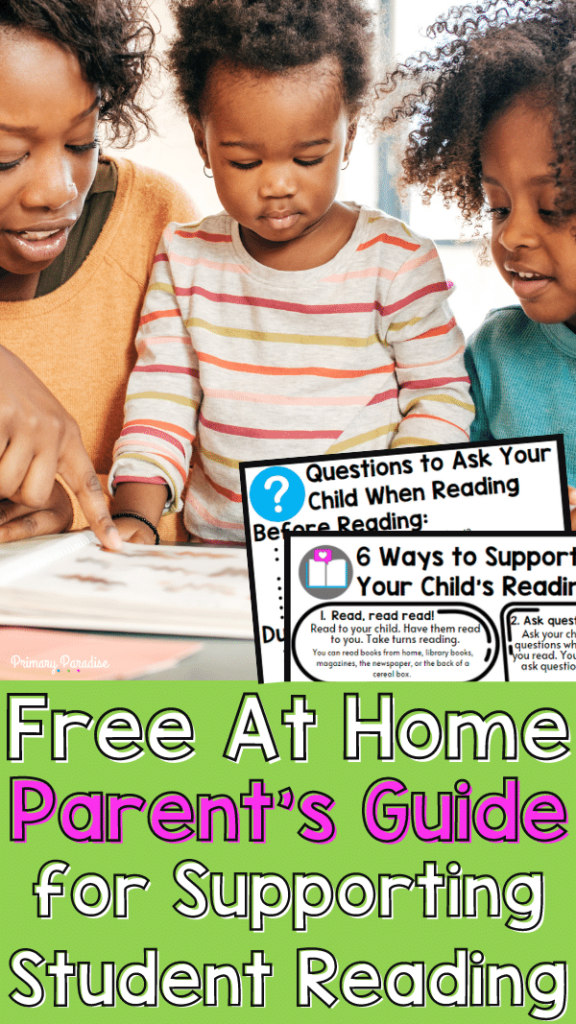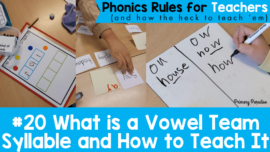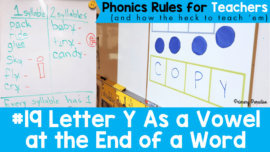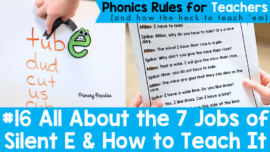Parents often want to help their children develop reading skills, but they’re not quite sure how to do it. They can be unsure where to even start. Today, I’m going to share 6 ways parents can help their children become stronger readers. I’m also going to share a free, printable guide you can send home with parents as well.
Read to Your Child
The first thing that parents can do to help their child grow as a reader is to read! Read to them. Read with them. Read together! If parents do nothing else besides reading with their child, they will have done enough. Here are the three ways parents can read with and to their child.
You Read
A classic story time. Sit down with your child, if possible, grab a book, and let them listen while you read. If you don’t have a ton of children’s books available, you can get books from the library, read any child friendly articles from magazines or the newspaper, or read the back of the cereal box.
They Read
Let children read to you. Of course support them as needed, but children enjoy getting to read to others. Again, encourage them to read whatever you have available. Even if their “reading” is mostly reciting a memorized book, that’s still great practice.
Shared Reading
Shared reading is fun because everyone gets a turn. It also takes the pressure off kids to have to read the whole book. It makes it easier for kids who are younger and might not have much reading stamina yet.
Ask Them Questions
As I said already, if parents just read with their kids, that’s truly enough. However, they can go above and beyond by asking questions to their children while they read. Asking questions, and encouraging children to ask questions, enriches the reading experience, improve comprehension, and helps students think and wonder. All of these are helpful reading skills.
Before
Here are some things parents can ask their child before reading a book.
- What do you think this story will be about?
- Do you think this book will be funny/serious/sad/spooky etc?
- Do you think this story will be real or made up?
- What do you wonder by looking at the cover?
- Who do you think the story will be about?
- When do you think the story is happening?
- Do you think you’ll like this book?
During
- What do you think will happen next?
- How does the character feel?
- Why do you think that happened?
- Would you have made that same choice?
- Let’s pause and talk about what’s happened so far.
- What is the most important thing so far?
- Have you learned anything new?
- Does this part remind you of anything?
After
- How did the book make you feel?
- What was your favorite part?
- How many stars would you give the book?
- Would you recommend it to a friend?
- Who were the characters?
- If you could change the ending, how would the story end?
- What would you have done if you were the main character?
- Tell me about this book in one sentence.
- Use one word to describe the book.
- Did this book remind you of anything?
- Would you like to read more books like this one?
- What are you still wondering?
- Can you tell your teddy bear (little brother, cat/fish etc) about the story?
These are, of course, just some examples. The more you can have a discussion about the book, the better. It’s not about students getting the answers “right” so much as talking through the story. It should feel like a conversation, not a quiz. Children are improving their reading comprehension skills. At the same time, they’re spending quality time with a family member. This will associate reading with good feelings which will make reading more appealing.
Tell Stories Together
Books are just written stories, so understanding story structure is a big part of reading. Another way parents can help students improve reading skills is by telling stories together. This is a great option during car rides, while waiting at the dentist, while running errands, or when taking an afternoon walk. Parents can tell stories and kids can listen. Kids can tell stories and parents can listen. However, my favorite way is telling stories together. Take turns saying a sentence or two and keep adding on to the story. The story will likely become silly, which makes it even more fun!
This is also a great way to include other siblings as well. Dad might start with “Once upon a time there was a big dragon named Steve.” And then the child might add, “Steve was riding his bike. He was going to have tea with his friend baby bunny.” And so on.
You can do this and just let the story wander and be silly. You can also try to make it a bit more structured. So, encourage children to come up with a few characters, add a specific setting, and include a problem and a solution. This simple activity is a fun way to practice reading and story skills in a way that doesn’t feel like reading.
Turn on the Subtitles
One of the easiest ways to help build reading skills is to turn on the subtitles or captions when your children are watching their afternoon TV show, or their Friday night movie. This helps students link written and spoke word. Even if they’re not explicitly trying to read the subtitles, they will notice words they know. It also links something they love already, TV, with reading and written words. There’s a ton of research that shows that this simple act can help children develop reading skills.
Look for Environmental Print
Environmental print is exactly what it sounds like. It’s print in our environment- the words that we see all around us. Street signs, billboards, store names, logos, labels, and so on. Encourage children to look for the words around them, and so they’ll notice that reading is everywhere! From their favorite cereal to their favorite restaurant and park. When there’s words around, (which is basically everywhere), parents can point this out. It’s amazing how many words children already know without even knowing it. A fun game I play with my own children when we’re walking around our city or waiting somewhere is to encourage her to find different words she knows. This reinforces the importance and prevalence of words as well as shows children how much they already know.
Let Them See You Reading
We all know children mimic the behavior they see, so if it’s possible, parents should let their kids see them reading. Parents can have a reading time where everyone in the family grabs a book and reads. Or, if parents like to read the newspaper or magazines, they can do it in front of their children. If parents don’t have the time to read, even just letting kids see them reading in their normal life, such as reading a recipe, a letter, an online article, is beneficial. And lastly, I know I often can’t read when my three kids are awake, but I do like to listen to audiobooks when I’m cleaning. I make a point to let them know I’m listening to a book.
If you’d like to share these tips with your students’ parents, you can download this free Parent’s Guide to Supporting Student Reading printable in my free resource library for email subscribers. Click the picture below to access it. Not an email subscriber? Sign up here for immediate access.

Keep reading and learning about how to support parents:
- Free Math Guide for Parents
- Free Phonics Guide for Parents
- Free Science Guide for Parents
- What to Include in a Parent Newsletter
- Top 5 Ways to Send a Parent Newsletter
- Help Parents Understand Why Some History is History




